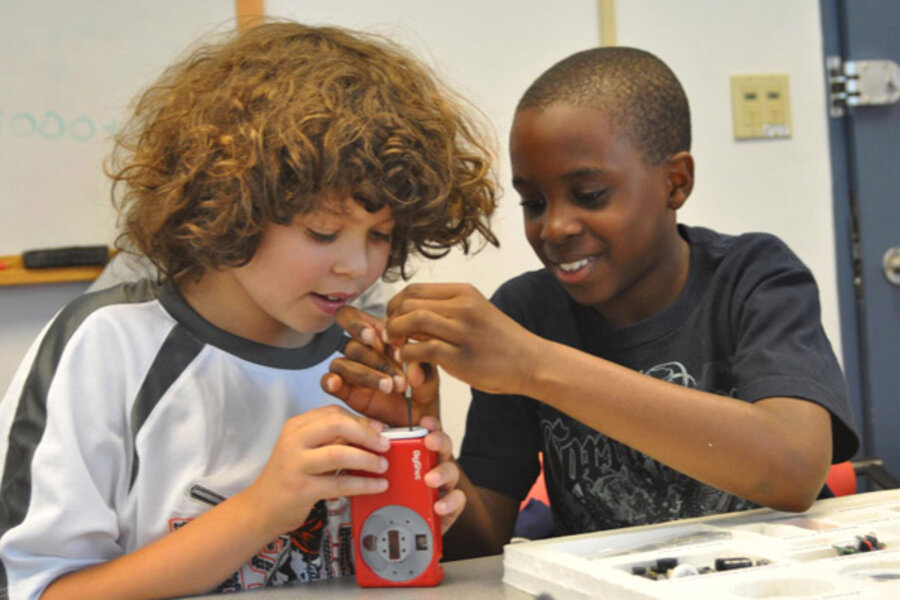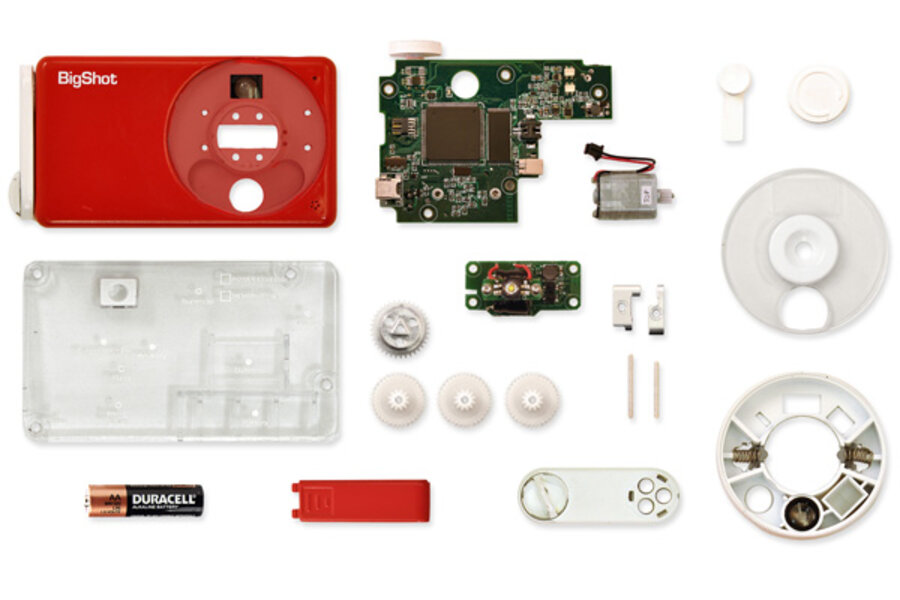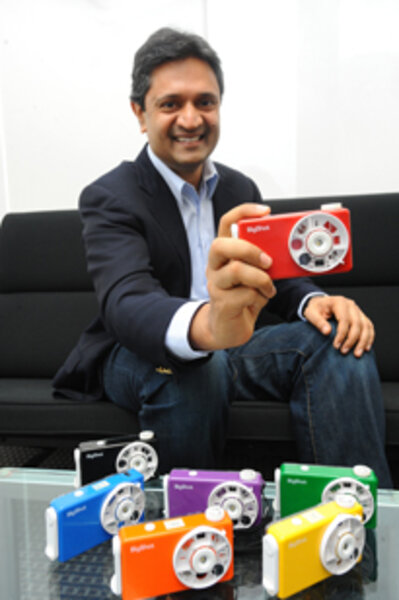BigShot: Snap-together camera introduces kids to tech, and to their world
Loading...
| New York
Nicholas Serbedio, a sixth-grader, has never seen a camera like this before. It’s bigger and heavier than usual, with a wide, gaping wheel on the front. On the back, where the viewing screen is “supposed” to be, there is a shimmering green circuit board.
“I was amazed,” Nicholas says of the moment a few hours earlier, when he first picked it up. “I thought, ‘How can a camera look like this? How can somebody build this?’ ”
Nicholas is possibly the most earnest of the 12 elementary school students attending a small workshop at Columbia University in New York City on a nasty winter Saturday. Though they’ve spent the morning fiddling with a special kind of camera called BigShot, it would be wrong to call this a photography workshop.
In fact, when Shree Nayar, the inventor of BigShot, looks at these kids, he doesn’t necessarily see budding artists; he sees cultural ambassadors, and even future engineers.
“BigShot is about: Here’s a camera, let’s build it and learn. Let’s go become photographers. Let’s learn about other cultures and communities,” he says.
Mr. Nayar conceived of BigShot four years ago as an educational trick of sorts. Painted in colors inspired by a bag of M&Ms, and large enough for kids to hold comfortably, BigShot is a build-it-yourself camera. It comes in a kit with less than 20 parts that snap and screw together simply. When it’s finished, users can peer through the transparent back and, with the help of labels preprinted on the plastic, show curious friends how the camera works. The labels point out the microprocessor, the memory chip, and other features that let this homemade device digitally capture, store, and reproduce images.
BigShot takes normal, panoramic, and even three-dimensional pictures – which, yes, require kids to don those blue- and red-lens glasses – but the real point of the camera isn’t the photos.
“It’s to use the camera as an excuse to expose [the kids] to as many science and engineering concepts as possible,” says Nayar, a professor of computer science at Columbia University.
That’s where the gadgets come in. Nayar’s camera has a crank on the right hand side and a dynamo – unequivocally the workshop group’s favorite piece – inside. The pieces work together to power the camera (in the unlikely absence of an AA battery) and to teach an engineering lesson.
“If the battery runs out, you can crank it,” explains sixth-grader MacKenzie Goulboum. “Then the dynamo gives it energy – I think.”
According to BigShot’s website, MacKenzie has pretty much got it. Turning the crank spins three gears inside the camera. That spinning generates energy, known scientifically as mechanical energy, that moves into the dynamo, a tiny power generator that turns mechanical into electrical energy. The electrical energy from the dynamo allows the camera to take a picture.
All of that is technically gratuitous, of course; this camera can run on a single battery. But things that spin, grind, and whir teach intimidating, and sometimes seemingly boring, science subjects.
“You can expose them to mechanics, to electromagnetism, to power generation and storage,” Nayar says. “The building process is a bait for learning.”
Before the students snap a piece in, they learn the science about how it works. They define pixels. They analyze beams of light. They compare the physiology of the human eye to this camera’s three lenses.
Nayar is something of a camera geek. A specialist in computational optics, he has invented far more sophisticated machinery, including a camera with a 360-degree “eye.” That camera takes circular pictures, which a computer later decodes and turns into sweeping, rectangular panoramic shots. The work stems from a lifelong fascination with art, and a firm belief in the unique role of the lens.
“It’s a very special piece of technology, the camera itself,” he says. “Using it is a very emotional thing. It allows us to express ourselves, to visually communicate with one another. To me, it represents the convergence of science and art, and today, it plays an enormous role in society.”
Nayar’s also the father of two young children, and he realized pretty quickly that when it comes to cameras, they are an untapped market.
“Kids don’t carry cash in their pockets. It’s parents who do,” he says. “There are cameras for kids that are just cheap pieces of plastic … so that if you bought a camera for your kid, and they broke it, you didn’t feel bad about it.”
But Nayar wanted to do more than sell a good camera to youngsters. He’d had the idea for BigShot in the back of his head for about a year when he saw the film “Born into Brothels,” a 2004-Oscar-winning documentary about the slums of India and the kids who, when given cameras by the director, movingly recorded the stories there.
“Watching that movie basically reaffirmed that the camera is a very powerful piece of technology, and that it could be a real draw for kids,” he says.
Ever the educator, Nayar wanted to do more than get kids taking pretty pictures. Adding simple, if unnecessary, gadgets to the camera was a start, but the college professor wanted something else: a textbook.
He and three graduate students designed Bigshotcamera.org as an “interactive textbook,” with animated illustrations that show how energy is converted, how an electrical charge moves through the camera’s circuitry, and how filling a frame with light – or removing it completely – can affect images. There are explanations of photons, a tutorial on how cameras use a numbered code to record images, and a discussion about how the computer translates the code into pictures.
It’s the photo galleries, though, where most of the interactivity takes place.
The website, though public, is still in testing, but visitors can view images from three focus groups that Nayar leads with graduate students Brian Smith, An Tran, and Guru Krishnan. (The latter two took BigShot to schools in their hometowns in Vietnam and India.)
Nayar has built a gallery of those images; He plans to expand slowly, starting with his next international workshop, in Japan in late December.
“[The camera] builds in tolerance. It dissolves biases,” he says. “It’s a way to show the kids that we’re all different in beautiful ways, but we’re all pretty much the same.”
Besides, there’s a natural draw, he thinks, in the chance to see how other people their age live in far-away places. The graduate students brought back to the US shots of middle schoolers posing with their friends in Vietnam’s busy public spaces, and candid stills of Indian schoolchildren eating lunch.
“Think about your kid, who here [in America] has a smart board and a projector and this amazing cafeteria, and you get exposed at a young age to this,” he says, looking at the lunchtime photos from India. “These kids come out with their bags, and in their bag they also have a little towel, which they unfold, on which the food goes.... There is no room to have lunch; they have an assembly space, and there are kids sitting all around.”
Like the photographers who use it, BigShot is still young. Nayar has gotten this far with the resources in his university research lab and with a grant from the search-engine giant Google. Eventually, he wants to turn the online gallery into a full-fledged social media site and make a commercial camera from his prototype.
At the moment, though, “I have exactly 12 of these,” he says. He wants to find a manufacturer who sees market value not just in the product, but in the project.
“I don’t want this to be seen as a toy,” he says. “I think that whoever decides to make these in large quantities must understand the value of this as well, or else you’ve kind of lost the point.”







